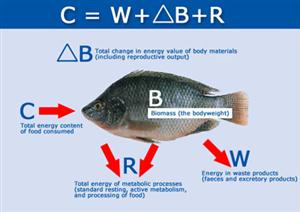Biomass and Production
Organisms use energy to maintain biological functions and to enable growth and reproduction. The organic matter produced by autotrophs and heterotrophs, in excess of what they need to sustain life, adds to the ecosystem's total biomass. The biomass in an ecosystem includes the mass of all living and dead organic matter. Production is the incremental increase in biomass produced by organisms over a period of time. Estimates of biomass and production are one measure that can be used to assess the health of aquatic ecosystems.
Primary production refers to the production of organic matter, such as body tissue, produced mainly by photosynthetic plants. It is expressed as a rate of biomass production—for example, the amount of wood produced each year.
Secondary production is the assimilation of organic material and building of tissue by heterotrophs, and may involve animals eating plants, animals eating other animals, or microorganisms decomposing dead organisms to obtain the resources (material, energy, nutrients) needed for producing biomass. Secondary production is also expressed as a rate of biomass production, such as the amount of meat produced by grazing cattle each year.
In a productive environment, living plant or animal tissue will accumulate over time. Biomass is the amount of this accumulated material at a given moment, while production is the rate of increase in the total biomass. In a river system, biomass may be lost by export (such as downstream transport of biomass), or gained by import from other systems (such as leaves falling into a stream).
Estimates of biomass and production can be applied at various spatial scales and to broad or narrow groups of organisms, such as all organisms in a lake, all fish in a lake, or all walleye in a lake. Production is often difficult to estimate, since it requires, among other things, accurate measures of biomass repeated at consistent intervals over a long period.
High biomass does not necessarily imply high production, and vice versa. For example, the biomass of plankton in a waterbody may be low, but because plankton grow and reproduce quickly, the plankton population may replace itself relatively quickly—it has a high rate of production.
Populations of large, long-lived fish represent a much greater biomass than the plankton; however, the production rate of large fish may be much lower. The rapidity with which living material can replace itself is measured by the production/biomass ratio. This ratio is high for plankton (high production, low biomass) and relatively low for fishes (low production, high biomass), and provides a better indication of energy transfer between trophic levels than instantaneous measures of biomass.









